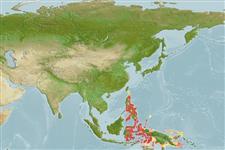Environment: milieu / climate zone / depth range / distribution range
Ökologie
seewasser riff-verbunden; tiefenbereich 0 - 30 m (Ref. 9710). Tropical; 23°N - 11°S, 120°E - 154°E (Ref. 5222)
Western Pacific: Vietnam, Indonesia, Philippines, Taiwan, Solomon Islands (Ref. 4787) and New Britain.
Size / Gewicht / Alter
Maturity: Lm ? range ? - ? cm
Max length : 30.0 cm TL Männchen/unbestimmt; (Ref. 5222)
Rückenflossenstacheln (insgesamt): 11; Rückenflossenweichstrahlen (insgesamt): 16-17; Afterflossenstacheln 3; Afterflossenweichstrahlen: 8. Characterized by grey brown color with scattered reddish brown to black spots; narrow pale margins on dark grey fins; body scales ctenoid, except cycloid scales dorsally and ventrally; body with auxiliary scales; greatest depth of body 2.8-3.2 in SL; rounded caudal fin; pelvic fins, 1.9-2.3 in head length (Ref. 90102); head length 2.3-2.6 times in SL; interorbital area flat to slightly convex, almost straight dorsal head profile; rounded preopercle, finely serrate, ventral serrae slightly enlarged; straight upper edge of operculum; maxilla reaches past rear edge of eye; 2 or 3 rows of teeth on midlateral part of lower jaw (Ref. 089707).
Found on mud or rocky or cobble bottoms (Ref. 089707). The species appears to be one of the rarest groupers in the Indo-Pacific region, nothing has been published on its biology. Solitary (Ref 90102).
Life cycle and mating behavior
Geschlechtsreife | Fortpflanzung | Ablaichen | Eier | Fecundity | Larven
Heemstra, P.C. and J.E. Randall, 1993. FAO Species Catalogue. Vol. 16. Groupers of the world (family Serranidae, subfamily Epinephelinae). An annotated and illustrated catalogue of the grouper, rockcod, hind, coral grouper and lyretail species known to date. Rome: FAO. FAO Fish. Synop. 125(16):382 p. (Ref. 5222)
IUCN Rote Liste Status (Ref. 130435)
Bedrohung für Menschen
Harmless
Nutzung durch Menschen
Fischereien: nicht kommerziell
Mehr Information
NamenSynonymeMetabolismusRäuberÖkotoxikologieFortpflanzungGeschlechtsreifeAblaichenSpawning aggregationFecundityEierEientwicklung
ReferenzenAquakulturAquakultur ProfilZuchtlinienGenetikElectrophoresesVererbbarkeitKrankheitenVerarbeitungNutrientsMass conversion
PartnerBilderStamps, Coins Misc.LauteCiguateraGeschwindigkeitSchwimmstilKiemenoberflächeOtolithsGehirngrößeSehfähigkeit
Tools
Zusatzinformationen
Download XML
Internet Quellen
Estimates based on models
Preferred temperature (Ref.
123201): 27.9 - 29.2, mean 28.8 °C (based on 557 cells).
Phylogenetic diversity index (Ref.
82804): PD
50 = 0.5000 [Uniqueness, from 0.5 = low to 2.0 = high].
Bayesian length-weight: a=0.01175 (0.00571 - 0.02419), b=3.04 (2.88 - 3.20), in cm total length, based on LWR estimates for this Genus-body shape (Ref.
93245).
Trophic level (Ref.
69278): 3.7 ±0.4 se; based on size and trophs of closest relatives
Widerstandsfähigkeit (Ref.
120179): mittel, Verdopplung der Population dauert 1,4 - 4,4 Jahre. (Preliminary K or Fecundity.).
Fishing Vulnerability (Ref.
59153): Low vulnerability (20 of 100).
Nutrients (Ref.
124155): Calcium = 42.1 [20.0, 85.2] mg/100g; Iron = 0.549 [0.303, 1.156] mg/100g; Protein = 18.5 [17.0, 19.9] %; Omega3 = 0.127 [0.079, 0.203] g/100g; Selenium = 26.6 [15.1, 46.8] μg/100g; VitaminA = 240 [66, 866] μg/100g; Zinc = 1.51 [1.03, 2.11] mg/100g (wet weight);
